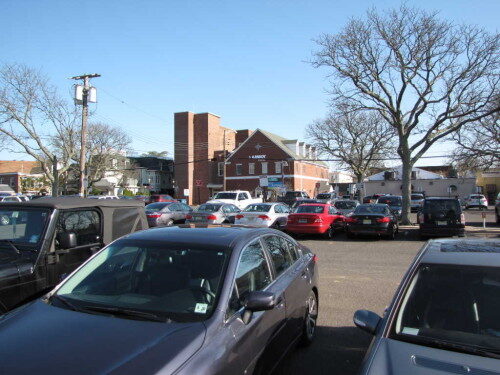
By JOHN T. WARD

Instead, local officials first have to fix a “broken” parking management system, they said.


Walker was hired hired by the borough last year to conduct the first full parking study in almost a generation. Here’s the complete report.
Anticipating several developments — the completion of an expansion now underway at the Count Basie Center for the Arts; the leasing of vacant retail space; and the lease-up of second-story office space — Krasnow and colleague Brian Bartholomew estimate the downtown could use an additional 221 parking spots on weekdays and 98 for evening and weekend use.
But a garage? Given that many of the borough’s parking woes are “self-inflicted,” Bartholomew said the borough needs to implement structural and operational changes first, and then revisit the question of whether a garage is needed in two years.
“Are we saying that you need a garage?” he said. “It would be foolish for us to say that you need a parking garage right now, based upon your current operational conditions, due to the fact that your parking program is broken.”
One aspect that’s broken, Bartholomew said, is the use of reserved spaces in the White Street lot for permit holders. Other customers are often forced to drive past empty permit spaces in rising frustration over not being able to use them, he said.
“Permit or monthly style parking should never be reserved: that’s a parking principle,” he said. “The only thing that monthly parking permits should do is to buy down the price of parking versus parking on a daily basis. That’s it. All municipal parking should be on a first-come, first-served basis.”
Checking license plates of vehicles using 105 curbside spaces for their study, Walker employees found ample evidence of multi-hour meter feeding, with 27 vehicles remaining dormant for four or more hours.
“That’s displacing upwards of 60 customers,” Krasnow said.
Walker’s recommendations targeted both the structure of the parking department and the management of the lots.
The foremost need, said Bartholomew, is for a professional parking manager.
“There’s no one person managing parking. There are a lot of hands managing parking,” he said. “And with that, a lot of best industry practices aren’t being adhered to.”
The manager should be tasked with negotiating shared usage agreements with private lot owners for peak demand times, he said. Privately owned parking is plentiful in the district, some of it available to the general public, the study found. It cited the garage at 141 West Front Street, next door to Pazzo restaurant, as an underutilized facility that’s open to the public after business hours, but little used.
Moreover, the borough government regularly taps the utility’s cash for non-parking expenses, which leaves no surplus, Bartholomew said.
The utility should be self-funded, and its coffers off-limits to the general fund, the report says. It recommends a three-year program of weaning the borough from parking utility revenue, in increments of $500,000, so that money can be dedicated to paving, new parking meters and other technology, Bartholomew said.
The report also says the borough should extend the hours of parking enforcement to 9 p.m. Monday through Saturday, to capture revenue left on the table under the current system, when enforcement nominally ends at 6 p.m.
Other recommendations call for better signage; “convenience pricing” for premium locations; moving all remaining permits from the White Street lot to other locations; and using license plate recognition technology to discourage daylong parking by students in the White Street lot.
The report lays out an implementation schedule and estimated costs.
Business Administrator Ziad Shehady told the audience the council’s parking committee would meet with stakeholders to address “what’s next.”
“We look at the recommendations in this report seriously, and with the interest of being able to implement them all as best as possible within our constraints financially and operationally,” Shehady said.
Danny Murphy, the owner of Danny’s Steakhouse and a longtime advocate for parking in the arts and antique district, offered a mixed review afterward.
“It certainly gave us more information than we might have had on our plates,” he told redbankgreen. “However, it doesn’t do anything to address the parking right now. We’re looking at a three-year plan, if we can implement it, and if the town is willing to give up the money from parking. That’s going to be the hardest part.”
The study was commissioned after nearly a year of political warfare over the future of the White Street lot. With then-Councilman Mike Whelan, a Republican, championing redevelopment of the 2.3-acre lot, merchants argued that the need for hundreds of new parking spaces was self-evident, and supported by earlier studies pointing to a shortfall of at least 1,000 spots.
In an open letter in August, 2017, downtown advocacy organization Red Bank RiverCenter said it would not support any plan that did not yield a net new 500 parking spots on the site, which then, as now, held 273 vehicles.
Last year, however, after Democrats had regained a majority and killed the redevelopment push, RiverCenter agreed to cover $25,000 of the $52,350 cost of the Walker study. And on Thursday night, RiverCenter executive director Jim Scavone said that the next challenge will be “determining the best path forward to implement all of these recommendations.”
Steve Catania, the owner of the Cheese Cave on Monmouth Street and chairman of the RiverCenter board of directors, also accepted the study and said it should be used as a guide for addressing problems.
“They’re the professionals. That’s why we hired them. At some point, you need to trust the professionals,” he said.
The borough hasn’t had a parking director since 2006, a year before the town settled allegations that director Neil Burnip had sexually harassed a female employee. Burnip was not a party to the settlement, and filed an $11.5 million suit against the borough over unrelated allegations, according to reporting at the time.





















